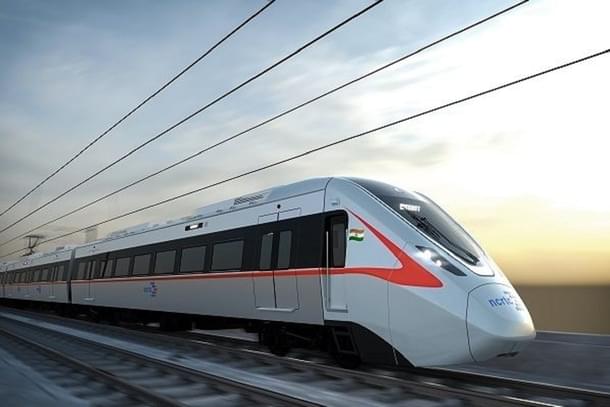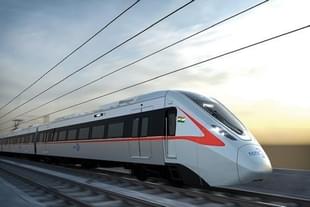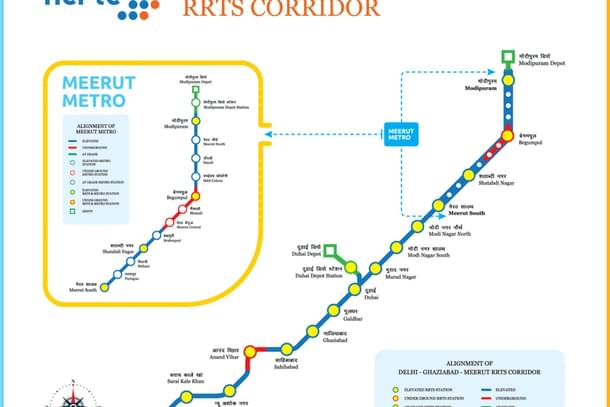News Brief
Delhi-Meerut RRTS: All About Namo Bharat Rapid Rail Corridor As PM Modi Opens 13 Km Sahibabad-New Ashok Nagar Stretch
Kuldeep Negi
Jan 05, 2025, 11:54 AM | Updated 12:58 PM IST
Save & read from anywhere!
Bookmark stories for easy access on any device or the Swarajya app.


Prime Minister Narendra Modi on Sunday (5 January) inaugurated the new 13-kilometre corridor the Delhi-Ghaziabad-Meerut Namo Bharat Regional Rapid Transit System (RRTS) which is worth Rs 4,600 crore.
The new corridor of Rapid Rail will connect Sahibabad in Uttar Pradesh's Ghaziabad with New Ashok Nagar in Delhi, marking the the first step in Namo Bharat connectivity for the national capital.
Here's all you need to know about the Delhi-Meerut RRTS corridor.
Project Overview:
The Delhi-Meerut Regional Rapid Transit System (RRTS), now known as "Namo Bharat," is an ambitious project aimed at transforming regional connectivity within India's National Capital Region (NCR).
This semi-high-speed rail corridor spans 82.15 km, connecting Delhi, Ghaziabad, and Meerut.
The system is designed to offer high-speed, high-frequency, and reliable commuter services, reducing travel time significantly between these cities.
Project Phases and Current Status:
Priority Section: The first phase, termed the priority section, stretches 17 km from Sahibabad to Duhai, which was inaugurated in October 2023.
This section includes five stations: Sahibabad, Ghaziabad, Guldhar, Duhai, and Duhai Depot, providing a taste of the system's capabilities.

Current Operational Length: As of the latest update, 42 km of the corridor between Sahibabad and Meerut South is operational, serving nine stations. A new 13 km section from Sahibabad to New Ashok Nagar is set to commence operations, bringing the operational length to 55 km with 11 stations.
Future Extensions: Plans are underway to extend the service to cover the full 82 km by mid-2025. Additionally, there's a proposal to extend from Meerut to Haridwar via Muzaffarnagar, which could reduce travel time between Delhi and Haridwar to just two hours if implemented.
Key Features:
Speed and Efficiency: Trains are designed to travel at a maximum speed of 180 km/h, with operational speeds up to 160 km/h, cutting travel time to less than 60 minutes for the full corridor.
Stations: The corridor will have 22 stations in total, with a mix of elevated and underground structures. Key stations include Nizamuddin/Sarai Kale Khan, Anand Vihar, Sahibabad, Ghaziabad, and several others in Meerut like Meerut South, Partapur, and Modipuram.
Integration: The RRTS integrates with other transport networks like the Delhi Metro, providing seamless connectivity. Stations like New Ashok Nagar, Anand Vihar, and Sarai Kale Khan are designed for multi-modal integration.
Technology and Sustainability: The system employs European Train Control System (ETCS) Level 2 for signalling and plans to meet 70 per cent of its energy needs through solar power, aiming for environmental sustainability.
Financials and Funding:
Cost: The total project cost is estimated at Rs 30,274 crore (approximately $3.8 billion).
Funding: This project is funded by a mix of government contributions from India, Delhi, and Uttar Pradesh, along with international financing from the Asian Development Bank (ADB), Asian Infrastructure Investment Bank (AIIB), New Development Bank (NDB), and Japan Fund for Poverty Reduction (JFPR).
Service Specifications:
Trains: Each train consists of 6 coaches, with the possibility to extend to 8 based on demand. The trains are manufactured by Alstom at their Savli plant in Gujarat, emphasising the 'Make in India' initiative.
Fares: For the standard class, fares range from Rs 30 to Rs 45 for the currently operational sections, with a one-way discounted fare of Rs 110 from Sahibabad to Meerut South. For premium class, fares vary from Rs 45 to Rs 165 based on distance.


According to reports, fares for the new route from New Ashok Nagar to Meerut South have been set at Rs 150 for standard coach passengers and Rs 225 for those opting for the premium coach.
Comparatively, a private AC bus from Delhi to Meerut costs around Rs 300 for a two-hour journey, while train tickets (like AC chair car) are priced between Rs 500-600 for a journey that takes about one hour and 15 minutes.
The Vande Bharat train to Dehradun with a stop at Meerut costs Rs 485 for a 58-minute journey.
Operations: Trains run every 15 minutes with services from 6 am to 8 pm, potentially expanding to 12 hours daily once fully operational.
Comparison with Alternatives:
Speed and Time: The RRTS offers significantly reduced travel times compared to road travel or even existing rail services, with the entire journey taking around 40-55 minutes.
Frequency: Trains are planned to run every five to ten minutes once the full corridor is operational, providing a high-frequency service that's closer to metro standards than typical inter-city rail travel.
Cost: While the initial fare for the RRTS might seem higher than some metro fares, it's competitive when compared to private bus services and inter-city trains, offering a balance between speed and cost.
Comfort and Amenities: The RRTS includes facilities like premium coaches with cushioned reclining seats, charging ports, and magazine holders, which are not standard in most metro or train services.
Impact and Benefits:
Economic and Social: By reducing travel times, RRTS is expected to spur economic growth, increase employment opportunities, and improve the quality of life through reduced congestion and pollution.
Environmental: The project aims to decrease vehicular emissions significantly, contributing to better air quality in one of the world's most polluted regions.
Urban Development: The corridor promotes balanced urban growth, encouraging development around stations, thus potentially alleviating pressure on Delhi's infrastructure.
Also Read: MEA Slams China's Move To Create New Counties That Include Parts Of Ladakh
Kuldeep is Senior Editor (Newsroom) at Swarajya. He tweets at @kaydnegi.





